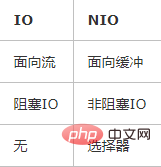
The main differences between IO and NIO in Java are as shown in the figure:

1. Stream-oriented and buffer-oriented
IO is stream-oriented, and NIO is buffer-oriented.
Java IO is stream-oriented meaning that one or more bytes are read from the stream at a time until all bytes are read, and they are not cached anywhere.
Java NIO's buffer-oriented approach is slightly different. The data is read into a buffer that it processes later, moving back and forth in the buffer as needed.
2. Blocking and non-blocking IO
The various streams of Java IO are blocking. When a thread calls read() or write(), the thread is blocked until some data is read, or the data is completely written.
The non-blocking mode of Java NIO allows a thread to send a request to read data from a certain channel, but it can only get the currently available data. If no data is currently available, nothing will be obtained. Instead of keeping the thread blocked, the thread can continue to do other things until the data becomes readable.
3. Selector
Java NIO's selector allows a single thread to monitor multiple input channels. You can register multiple channels using one selector. A separate thread is then used to "select" channels that already have input that can be processed, or select channels that are ready to be written to. This selection mechanism makes it easy for a single thread to manage multiple channels.
Recommended tutorial: java tutorial
The above is the detailed content of The difference between java nio and io. For more information, please follow other related articles on the PHP Chinese website!

Hot AI Tools

Undress AI Tool
Undress images for free

Undresser.AI Undress
AI-powered app for creating realistic nude photos

AI Clothes Remover
Online AI tool for removing clothes from photos.

Clothoff.io
AI clothes remover

Video Face Swap
Swap faces in any video effortlessly with our completely free AI face swap tool!

Hot Article

Hot Tools

Notepad++7.3.1
Easy-to-use and free code editor

SublimeText3 Chinese version
Chinese version, very easy to use

Zend Studio 13.0.1
Powerful PHP integrated development environment

Dreamweaver CS6
Visual web development tools

SublimeText3 Mac version
God-level code editing software (SublimeText3)
 VSCode settings.json location
Aug 01, 2025 am 06:12 AM
VSCode settings.json location
Aug 01, 2025 am 06:12 AM
The settings.json file is located in the user-level or workspace-level path and is used to customize VSCode settings. 1. User-level path: Windows is C:\Users\\AppData\Roaming\Code\User\settings.json, macOS is /Users//Library/ApplicationSupport/Code/User/settings.json, Linux is /home//.config/Code/User/settings.json; 2. Workspace-level path: .vscode/settings in the project root directory
 How to handle transactions in Java with JDBC?
Aug 02, 2025 pm 12:29 PM
How to handle transactions in Java with JDBC?
Aug 02, 2025 pm 12:29 PM
To correctly handle JDBC transactions, you must first turn off the automatic commit mode, then perform multiple operations, and finally commit or rollback according to the results; 1. Call conn.setAutoCommit(false) to start the transaction; 2. Execute multiple SQL operations, such as INSERT and UPDATE; 3. Call conn.commit() if all operations are successful, and call conn.rollback() if an exception occurs to ensure data consistency; at the same time, try-with-resources should be used to manage resources, properly handle exceptions and close connections to avoid connection leakage; in addition, it is recommended to use connection pools and set save points to achieve partial rollback, and keep transactions as short as possible to improve performance.
 python itertools combinations example
Jul 31, 2025 am 09:53 AM
python itertools combinations example
Jul 31, 2025 am 09:53 AM
itertools.combinations is used to generate all non-repetitive combinations (order irrelevant) that selects a specified number of elements from the iterable object. Its usage includes: 1. Select 2 element combinations from the list, such as ('A','B'), ('A','C'), etc., to avoid repeated order; 2. Take 3 character combinations of strings, such as "abc" and "abd", which are suitable for subsequence generation; 3. Find the combinations where the sum of two numbers is equal to the target value, such as 1 5=6, simplify the double loop logic; the difference between combinations and arrangement lies in whether the order is important, combinations regard AB and BA as the same, while permutations are regarded as different;
 Mastering Dependency Injection in Java with Spring and Guice
Aug 01, 2025 am 05:53 AM
Mastering Dependency Injection in Java with Spring and Guice
Aug 01, 2025 am 05:53 AM
DependencyInjection(DI)isadesignpatternwhereobjectsreceivedependenciesexternally,promotingloosecouplingandeasiertestingthroughconstructor,setter,orfieldinjection.2.SpringFrameworkusesannotationslike@Component,@Service,and@AutowiredwithJava-basedconfi
 python pytest fixture example
Jul 31, 2025 am 09:35 AM
python pytest fixture example
Jul 31, 2025 am 09:35 AM
fixture is a function used to provide preset environment or data for tests. 1. Use the @pytest.fixture decorator to define fixture; 2. Inject fixture in parameter form in the test function; 3. Execute setup before yield, and then teardown; 4. Control scope through scope parameters, such as function, module, etc.; 5. Place the shared fixture in conftest.py to achieve cross-file sharing, thereby improving the maintainability and reusability of tests.
 How to obtain digital currency BTC? What are the differences between btc and digital currency?
Aug 01, 2025 pm 11:15 PM
How to obtain digital currency BTC? What are the differences between btc and digital currency?
Aug 01, 2025 pm 11:15 PM
There are four main ways to obtain BTC: 1. Register and exchange it with fiat currency or other digital assets through centralized trading platforms such as Binance, OK, Huobi, and Gate.io; 2. Participate in P2P platforms to directly trade with individuals, and pay attention to the credit risks of the counterparty; 3. Provide goods or services to accept BTC as payment; 4. Participate in airdrops, competitions and other platform reward activities to obtain a small amount of BTC. The core difference between BTC and digital currency is: 1. BTC is a type of digital currency, which belongs to a genus relationship; 2. BTC adopts a proof of work (PoW) mechanism, while other digital currencies may use various technologies such as proof of stake (PoS); 3. BTC emphasizes the value storage function of "digital gold", and other digital currencies may focus on payment efficiency or
 How to work with Calendar in Java?
Aug 02, 2025 am 02:38 AM
How to work with Calendar in Java?
Aug 02, 2025 am 02:38 AM
Use classes in the java.time package to replace the old Date and Calendar classes; 2. Get the current date and time through LocalDate, LocalDateTime and LocalTime; 3. Create a specific date and time using the of() method; 4. Use the plus/minus method to immutably increase and decrease the time; 5. Use ZonedDateTime and ZoneId to process the time zone; 6. Format and parse date strings through DateTimeFormatter; 7. Use Instant to be compatible with the old date types when necessary; date processing in modern Java should give priority to using java.timeAPI, which provides clear, immutable and linear
 What are the differences between USDT standard, USDC standard and currency standard? Monetary Circle
Jul 31, 2025 pm 08:21 PM
What are the differences between USDT standard, USDC standard and currency standard? Monetary Circle
Jul 31, 2025 pm 08:21 PM
In the digital asset derivatives market, contract trading is one of the core ways to play, and understanding different margin types is the first lesson for beginners. Choosing USDT, USDC, or currency standard contracts is directly related to your income calculation method and risk exposure. Understanding their differences will allow you to make better decisions in market fluctuations. If you have higher requirements for the compliance and transparency of funds, then choosing a USDC-based contract supported by large platforms such as Ouyi OKX and Binance will make you feel more at ease.






